
vibrating sample magnetometer
Color : Light Grey

Two Probe Setup
1 Set(s) (MOQ)
We offer Two Probe Method, it is one of the standard and most commonly used method for the measurement of resistivity of very high resistivity samples like sheets/films of polymers. The resistivity measurement of such samples is beyond the range of Four Probe Method. The experimental Set-up consists of the following: 1. Two Probes Arrangement, TPA-01 It has two spring load contact probes. These probes move in a pipe and are insulated by Teflon washers. This probes arrangement is mounted in suitable stand, which also hold the sample plate and RTD sensor. The stand also serves as the lid of PID controlled Oven. Teflon coated leads are provide for connecting with High Voltage Power Supply EHT-11 and Digital Picoammeter DPM-111. With the set-up assuming max. voltage = 1500V; current 100x10-12 A (max) and thickness of sample 1mm. The resistivity of the sample could be measured upto 1014 ohm.cm. 2. PID Controlled Oven, PID-200 This is a high quality temperature controlled oven suitable for Four Probe Set-up. The oven has been designed for fast heating and cooling rates, which enhances the effectiveness of the controller. While the basic design of the controller is around the PID configuration for its obvious advantages, wastage of power is avoided by using a Pulse Width Modulated (PMW) switch. This combination has the advantages of both on-off controller and linear PID controller. The result is a good stable and accurate temperature control. Platinum RTD has been used for sensing the temperature. A wheatstone bridge and an instrumentation amplifier are used for signal conditioning. Feedback circuit ensures offset and linearity trimming to a great degree of accuracy. The set and measured temperature are displayed on 3½ digit DPM through selector switch. Specifications of the Oven Temperature Range: Ambient to 200°C Resolution: 0.1°C Short Range Stability: ±0.2°C Long Range Stability: ±0.5°C Measurement Accuracy: ±0.5°C (typical) Oven: Specially designed for Two Probe Set-Up Sensor: RTD (A class) Display: 3½ digit, 7 segment LED Power: 150W 3. High Voltgae Power Supply, EHT-11 Output: 0-1500V continuously adjustable Current: 1mA (max.) Polarity: +ve or -ve, as required Regulation: ±0.05% for 0 to 1mA load Stabilization: ±0.02% for ±10% mains variation Display: 3½ digit, 7 segment LED DPM Connection: Output through a amphenol connector on the front panel Protection: Fully protected against overload and short circuit by current limiting technique Power requirements: 220V ±10%, 50Hz Weight: 5Kg Dimensions: 240mm X 390mm X 130mm. 4. Digital Picoammeter, DPM-111 Multiplier: X1, X10, X102, X103 , X104 , X105 Accuracy: 0.2% for all ranges Resolution: 1pA, 10pA, 100pA, 1nA, 10nA, 100nA Input Resistance: 2.5KΩ, 0.25KΩ, 25Ω, 2.5Ω, 0.25Ω, 0.025Ω Display: 3½ digit, 7 segment LED (12.5mm height) with auto polarity and decimal indication. Input: Through Amphenol connector. Power Supply: 220V±10%, 50Hz. Weight: 2.5Kg. Dimensions: 240mm X 275mm X 120mm. The experimental set-up is complete in all respect.
...more
True RMS A.C. Milli Voltmeter
1 Piece(s) (MOQ)
We offer precision A.C. Milli-voltmeter very useful in general laboratory and R&D labs. AC Milli-voltmeter is a very versatile instrument of accurate measurement of low signal like microphone outputs, Amplifier frequency response, RMS voltage measurement etc. Features: Measures True RMS Voltage Accuracy 1% High Input Impedance High Stability Excellent Linearity Applications Measurement of low signal like microphone outputs e.g. in r.m.s. sound level monitoring Amplifier frequency response well beyond audio ranges RMS voltage measurement of modulated signals Power measurements with external standard resistance Specifications Voltage Range: 20mV, 200mV, 2V and 20V Frequency Range: 10Hz to 200KHz Input Impedance: 1MΩ shunted by 25pf on all ranges Accuracy: 1% in the range 10Hz-100KHz; 2% in the range 100KHz-200KHz Display: 3½ digit, 7 segment LED (12.5mm height) with decimal and overflow indication Power Supply: 220V ±10%, 50Hz Weight: 2.5Kg & 3Kg Accessories: 75cm shielded cable with a coaxial connector at one end and banana plugs on the other end ACM-103 (Additional Features) Oscillator Output: 0-300mV continuously variable Frequency: 1KHz fixed
...more
Travelling Microscope
1 Piece(s) (MOQ)
We Offer High Quality Traveling Microscope Whose Bed is of a Heavy Casting, Thoroughly Aged and Machined, is Fitted with Leveling Screws. On the Dovetailed Guide Ways Slide the Carriage Which Can Be Clamped At Any Position By Means of a Thumbscrew. a Sliding Carriage Slides Along a Gunmetal Vertical Pillar Fitted On the Horizontal Carriage. the Slow Motion Guide Bars are Made of Sturdy Material and the Motion is Very Smooth. microscope Tube indeclinable in Any Angle. True Vertical and Horizontal Positions Marked Focusing. guide Ways the Guide Ways Over Which Slides the Carriage is Made of Gunmetal and this Makes the Instrument Rust Proof, Because this is the Part Which is Directly Exposed to the Weather. scales and Verniers made of Lifetime Stainless Steel. optics (i) True Achromatic Objective with 7.5 Cm. Focusing Distance from Object (ii) 10x Ramsden Eyepiece with fine Cross Wire scale and Vernier (i) Horizontal Scale : 18cm Divided At 1mm Interval. (ii) Vertical Scale : 16cm Divided At 1mm Interval. (iii) Screw Gauge Dial : 100 Divisions with a Least Count of 0.01mm.
...more
Travelling Microscope
1 Piece(s) (MOQ)
Condition : New
Brand Name : SES
Color : Grey
...more
Temperature Control System
1 Sets (MOQ)
Color : Grey
Brand Name : Techno

Study of Thermoluminescence of F-centers Experimental setup
1 Set(s) (MOQ)
We offer Study of Thermoluminescence of F-centers, TLX-02 in Alkali Halide Crystals. A colour centre is a lattice defect that absorbs visible light. These colour centers can be produced by heating the crystal in excess of alkali vapour or by irradiation. The colour centers formed due to trapped electrons or trapped holes can be destroyed (bleached) by illuminating with light or warming. Important information about the colour centers can be obtained from the plot of luminescence intensity vs. temperature, taken at a constant heating rate called glow curve. It may contain one or many glow peaks, depending upon whether there are one or several different kinds of traps. The experiment consists of the following: (a) Experimental set-up for creatingvThermoluminescence (1) Sample: KBr (TLS-KBr) and KCl (TLS-KCl) single crystal (2) Thermoluminescence Temperature Meter, TL-02 • Digital Thermometer with RTD sensor • Oven power supply (3) Sample holder (4) Thermoluminescence Oven (upto 423K), TLO-02 (5) Black Box, TL-BBx (b) For measurement of Luminescence Intensity (1) Photomultiplier tube 931A, TL-PMT (2) PMT Housing with biasing circuit and connecting coaxial cables, TL-PMH (3) High Voltage Power supply, EHT-11 (4) Digital Nanoammeter, DNM-121 Complete in all respect, only X-ray facilities are required to create F-centers in the crystal.
...more
Study of Temperature Transducers
1 Piece(s) (MOQ)
We offer Study of Temperature Transducers, STT-01usefull for control labs. Measurement of temperature is an important task in a large number of physical processes. A transducer in a device which converts the temperature information into an electrical signal usually voltage, for an automated processing. A very wide variety of temperature transducers are commonly available which differ from each other with regards to there: (a) Range of operation (b) Sensitivity and linearity (c) Accuracy, Stability and Repeatability (d) Speed of response The present experiments has been designed to study the input-output characteristics of some common transducers like, thermistors (PTC and NTC), thermocouple, semiconductor sensors and may be extended to also study the temperature coefficients of resistance. >> Highlights:- Temperature controlled oven with digital display Instrumentation amplifier with gain switching Digital voltmeter Interfacing circuits for common transducers >> Experiments:- Temperature-output voltage characteristics of the following transducers in the temperature range of room temperature to 150°C and determination of their parameters Thermocouple - Chromel - Alumel - Copper - Constantan Thermistors Semiconductor sensor (type AD590) upto 90°C only >> Features and Specifications:- Temperature controlled oven upto 150°C with digital temperature display Digital voltmeter on the panel for sensor output measurement Built-in interfacing circuit and switched gain instrumentation amplifier IC regulated power supplies and detailed manual The experiment is complete in all respect.
...more
Study of Synchro Devices
1 Piece(s) (MOQ)
We Offer Study of Synchro Devices Useful for Control Labs. highlights synchro Transmitter-receiver Pair with Calibrated Dials locking System for Receiver Rotorreceiver Use as Control Transformer built-in Balanced Demodulator Circuit panel Meter for Ac/dc Voltages all Internal Power from the 220 V/50 Hz Mains Only An External Cro Required >>introduction Basic Characteristics Study - Stator Voltages as a Function of the Rotor Angle Using the Built-in Ac Voltmeter. this Shows the Space Variation of the Three Voltages, Vs1s2, Vs2s3, and Vs3s1, Causing Rotation of the Resultant Magnetization in the Stator Which is Fundamental to the Error Detection Process. Operation and Error Study of the Transmitter-receiver Pair as a Simple Open Loop Position Control At a Very Low Torque. this is a Rarely Used Application But is Used to Demonstrate the Direction of the Resultant Magnetic Field in the Receiver. Plotting the Error Voltage Output as a Function of the Transmitter Rotor Angle with the Receiver Rotor Locked. Observing the 180° Phase Reversal Around the Zero Error is Significant as this the Basic Method Through Which the Direction of the Error is Detected in An Ac System Use of Balanced Demodulator to Develop Dc Error Signal with Appropriate Polarity and Compare It with the Ac Error. this Block Would Be Needed if a Mixed System Were to Be Designed Using Both Dc and Ac Components. the Experiment is Complete in all Respect Except a Cro.
...more
Study of Stepper Motor
1 Piece(s) (MOQ)
We offer Study of Stepper Motor useful for control labs. This experimental set-up aims at providing an exposure to the basic operation of a stepper motor, its drive and logic, and limitations as far as the internal dynamics is concerned. >>Highlights Stepper motor operation through pulse circuit Stepper motor operation through 8085 mp kit Built-in programs in EPROM Dynamic response study >>Experiments Manual stepping through push button switch. Measurement of step angle. Speed and direction control logic by recording the pulse sequence. Study of resonance effect at various speeds Display and measurement of the dynamic characteristics of the motor in the wobble mode. Calculation of ‘single stepping’ and ‘slew’ regions. Programming the microprocessor kit to implement features like direction, speed, angle of rotation, number of steps or an arbitrary motion Study of the effect of inertial and frictional loading on the dynamic performance >>Features and Specifications Single stepping and free running modes of operation with speed variation and direction reversal - internal TTL circuit. 360° motion Servo-Potentiometer position -pickup for motor dynamics Operation through microprocessor kit – sample control programs provided Stepper motor specification Torque: 2.8 Kg-cm Step angle: 1.8° Power: 12V, 1A/phase Essential accessory – a CRO The experiment is complete in all respect except a CRO.
...more
Study of Second Order Networks
1 Piece(s) (MOQ)
We offer Study of Second Order Networks useful for control labs. Second order networks are important because of the fact that these are the simplest networks that produce the complete range of transient response – from over damping to near oscillations. Although theoretical discussions are normally confined to passive RLC networks, such networks are limited in their performance due to the rather large resistance of any reasonable value inductance that might be constructed to operate at frequencies of few kHz. In the present unit active RC-network has been designed which span the complete behavior of an equivalent passive RLC network. The user thus has the experience of studying a near ideal passive second order network complete with all theoretical computations and their experimental verifications. >>Highlights Active second order network Damping control–over-, critical-, and under-damping Built-in sine wave signal Needs an external CRO for response study Operates with 220V/50 Hz Detailed technical literature and experiment results supplied >>Experiments Observe and trace from the CRO screen the step response for different values of ζ. Compute approximate values of equivalent network parameters. Plot the frequency response for various of ζ and observe resonance >>Features and Specifications Active RLC network using 3-Op Amps Damping 1.1-0.1 (approx) Square Wave 35-700 Hz., 0-1V (typical) Sine Wave 35-700 Hz., 0-1V (typical) Essential accessory: a CRO The experiment is complete in all respect, except a CRO.
...more
Study of P-N Junctions
1 Piece(s) (MOQ)
We offer Study of P-N Junction, this is an advanced level experiment to be performed on commercially available diodes viz. germanium or silicon diodes, various types of LED’s and also on the base-emitter/collector-base junctions of a transistor. The results of the experiments not only give the device characteristics but also provide an insight into the properties of the materials used in the fabrication of the junction. In the set-up, all the necessary instrumentation is integrated as a result of which a minimum of external connections need to be made by the user. A CRO is the only accessory that is required. The following studies can be carried out. (i) Reverse saturation current l0 and material constant h (ii) Temperature coefficient of junction voltage dV/dt (iii) Energy band-gap VG0 (iv) Junction capacitance The experimental set-up consists of the following: (1) Study of P-N Junctions, Model PN-1 (a) 3½ digit DPM for current/ temperature measurement. (b) 3½ digit DPM for bias voltage/ junction voltage measurements. (c) To connect the diode – one for experiment 1 & 2 and other for experiment 3. (d) Two fixed frequency oscillators (5KHz & 20KHz) with the same output (200mV). (2) Fast temperature controlled oven with sensor, PNO-01 (3) PNJ-Sample (a) Transistor BC109 (base-emitter)-Si (b) Transistor AC128 (base-emitter)-Ge (c) Diode: IN 5408/IN 4002-Si The unit is supplied complete with a detailed instruction manual. Sufficient theoretical description is included for a proper understanding. This is followed by a step-by-step procedure and a typical set of readings and results. The set-up is complete in all respect, except a CRO which is required for measurement of junction capacitance. The experiment is complete in all respect.
...more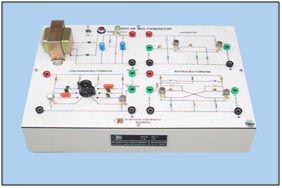
Study of Multivibrators
1 Piece(s) (MOQ)
We offer Study of Multivibrators, this experiment consists of the following: Free Running vibrator Univibrator Bistable Multivibrators Regulated Power Supply The free running multivibrator also serve as a pulse generator for the study of bistable multivibrator and univibrator. The set-up is so designed that no high voltage is exposed and hence safe in handling by the students.
...more
Study of Modulation, Demodulaion
1 Piece(s) (MOQ)
We offer Study of a Modulation and Demodulation with Built-in Carrier Frequency Source (Solid State), the following studies can be carried out with this set-up: Carrier signal testing. Variation of modulated wave with the modulation signal. Study of detector circuit. The experimental set-up is provided with a built-in power supply. Accessories Required: (i) Function Generator, FG-01 (ii) Oscilloscope The set-up is so designed that no high voltage is exposed and hence safe in handling by the students.
...more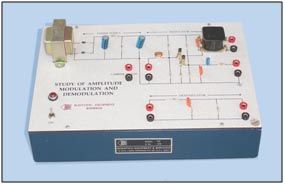
Study of Modulation , Demodulaion
An Experiment Designed for Study of Carrier Signal, Variation of Modulated Wave and Detector Circuit.
...more
Study of Magnetic Levitation System
1 Piece(s) (MOQ)
We offer Study of Magnetic Levitation System useful for control labs. Magnetic Levitation, lifting of objects under the influence of a magnetic field, has numerous application including some advance locomotives designed on the repulsive force of a magnet. The present unit, based on the attractive force of an electromagnet, is inherently unstable. There is no way to keep an iron object suspended in air by manually adjusting the current in the electromagnet. Even a feedback control with forward path gain control alone is ineffective. These facts are brought out by studying and experimenting with the dynamics of the system. The next task consists of the design of suitable controller and implementing the same to achieve the desired objective. A sound knowledge of MATLAB and its availability should be highly desirable, though not essential, for the conduct of this experiment. The basic theory, analysis and sample calculation are described in the accompanying literature. >>Highlights Object suspended in air by magnetic force – excellent visual impact Controller design to maintain stability Up-down position setting by reference control >>Experiments To develop the transfer function of the system through laboratory To design/implement PD and lead compensation with different parameter To simulate the system in MATLAB and study in detail various control option and their response >>Features and Specifications Object suspended in air by magnetic force Controller design to maintain stability Position changing by reference Built-in power supplies, meters etc 220V/50Hz operation Detailed technical literature included The experiment is complete in all respect.
...more
Study of Hybrid Parameters of a Transistor Experimental Setup
1 Piece(s) (MOQ)
We offer Study of Hybrid Parameters of A Transistor, HP-01 the following studies can be carried out with this set-up: Study of h11 parameter (input impendance parameter). Study of h22 parameter (output admittance parameter). Study of h21 parameter (forward current transfer ratio). Study of h12 parameter (reverse voltage feedback ratio). The experimental set-up is provided with a built-in power supplied and is complete. The set-up is so designed that no high voltage is exposed and hence safe in handling by the students.
...more
Study of Digital to Analog Converter
1 Piece(s) (MOQ)
We offer Study of Digital-to-Analog Converter, DTA-01 useful for control labs. Measurement of the speed of a rotating shaft is a common requirement in many industrial and laboratory applications. Stroboscope, is a convenient-to-use, direct reading speed measuring instrument. A highly stable function generator IC based circuit provides the basic variable frequency timing pulses. These are read on an IC based LCD/LED counters with direct speed display in rpm. The flasher unit generates the high intensity flashes at a suitably scaled rate directed towards the rotating shaft. Precision potentiometer's makes the task of speed setting very precise. The portable model, fitted into a light weight and strong plastic body is more suited for industrial / class room environment. >> Highlights:- Basic 4-bit weighted resistance 4-bit R-2R network module 10-bit IC Type AD7533 with mechanical switches MIcroprocessor interfaced 10-bit converter >> Experiments:- Study of the circuit diagram and performance of a 4-bit weighted resistance type D/A converter. The digital inputs are to be given by operating four mechanical switches. The above experiment is conducted on a 4-bit discrete component R-2R network based unit. Manual operation of a 10-bit IC D/A converter type AD7533 through 10 mechanical switches. Operation of the IC based circuit through the microprocessor kit provided. Some typical waveform generation exercises are suggested and solutions are provided. More problems can be attempted by the student with help from his supervisor. >> Features and Specifications:- Advanced Experiments-arbitrary waveform generation Panel Meter for all measurements A measuring CRO is needed for viewing the waves forms The experiment is complete in all respect, except a CRO.
...more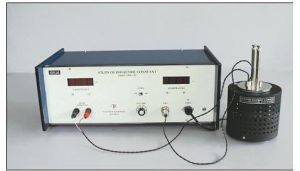
Study of Dielectric Constant
1 Piece(s) (MOQ)
Our Dielectric Constant Setup is a laboratory experiment to demostrate to the students the concept of Dielectric Constant, its measurement, measurement of curie temperature. Dielectric or electrical insulating materials are understood as materials in which electrostic field can persist for long times. Layers of such substances are commonly inserted into capacitors to improve their perfomance, and the term dielectric refers specifically to this application. An electric field polarizes the molecules of dielectric, producing concentrations of charge on its surface that create an electric field opposed (antiparallel) to that of capacitor. This reduces the electric potential. Considered in reverse, this means that, with a dielectric, a given electric potential causes the capacitor to accumulate a larger charge. All ferroelectric materials have a transition point called the Curie point (Tc). At T>Tc, the crystal does not exhibit ferroelectricity, while for T
...more
Study of Basic Operational Amplifier
An Experiment Designed for Study Basic Working of 741-ic Measurement of Its Bias and Offset Currents, Study of Inverting & Non-inverting Configuration and Study of Amplifier Drift.
...more
Study of Astable & Monostable Multivibrator using Timer IC, Type- 555
1 Piece(s) (MOQ)
We offer Study of Astable & Monostable Multivibrator using Timer Ic, TYPE-555, the following studies can be carried out with this setup: Operation as a free running multivibrator Operation as a monostable multivibrator Operations as a preset time delay. The set-up is so designed that no high voltage is exposed and hence safe in handling by the students.
...more
Study of an Integrated Circuit Regulator
1 Piece(s) (MOQ)
We offer Study of Integrated Circuit Regulator, the following studies can be carried out: (i) Study of a voltage regulator. (ii) Study of a current regulator. The experimental set-up consists of an IC 723 with facilities for convenient connections, an unregulated power supply, voltmeter, an ammeter and all the other components required to perform the experiments. The set-up is so designed that no high voltage is exposed and hence safe in handling by the students.
...more
Study of a Transistor Amplifier (RC Coupled) Cum Feed-Back Amplifier
1 Piece(s) (MOQ)
We offer Study of a Transistor Amplifier (Rc Coupled) Cum Feed-Back Amplifier with this following studies can be carried out with this set-up Study of the basic circuit of a RC Coupled Amplifier. Frequency response of RC Coupled Amplifier. Effect of negative feedback on the gain and frequency response of the amplifier Effect of positive feedback on the gain and frequency response of the amplifier. Verification of the condition of oscillation. Study of different classed of amplifier. Accessories Required (i) R.F. Oscillator (ii) True RMS A.C. Millivoltmeter, ACM-102 The set-up is so designed that no high voltage is exposed and hence safe in handling by the students.
...more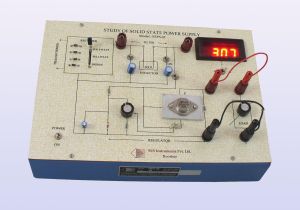
Study of a Solid State Power Supply
1 Piece(s) (MOQ)
We offer Study of a power supply (Solid State) physics ans electronics experimental setup. The Set-up consists of a step-down transformer, a rectifier circuit (can be used as a half-wave or a full-wave rectifier), a filter circuit (an inductance and two capacitors) - the arrangement can be used for the study of various configuration of filters and a regulator circuit. A built-in electronic load is used to smoothly vary the load current while a digital panel meter on the board measures the load current and load voltage. FEATURES 1. Study of rectification: (a) Full wave rectification (b) Half wave rectification (c) Bridge rectification 2. Study of ac component: (a) Efficiency of various (Ripples) type of filters L, Π, T type etc. (b) The effect of load (c) The effect of regulation 3. Regulation characteristics: (a) The effect of load on regulation (b) The effect of change in main’s voltage 4. Electronic Load: To draw the load current smoothly SPECIFICATIONS Output: 0-12 volts Max. Current: 200 mA Regulation: 1% Metering: Output Voltahe/ Current on the switchable DPM The experimental set-up is complete in all respect, except a Multimeter and a CRO
...more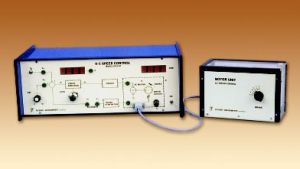
DC Speed Control System
1 Piece(s) (MOQ)
We offer D.C. Speed Control System useful for control labs. The present unit, built around a small permanent magnet d.c. motor, is designed to bring out the salient features of such a system. Facilities are available to directly measure the principal performance features of the speed control system, viz., steady state error and load disturbance rejection, as a function of the forward path gain. In addition, the experimental work involves the determination of the motor transfer function and the characteristics of the tachogenerator. Highlights: Closed loop motor speed control with eddy current brake Compact system-no mechanical hassles Optoelectronic speed sensor Digital display of speed on the panel Experiments: Effect of loading on the speed of the motor in the open loop Steady state error variation with forward gain System time constant variation with forward gain Effect of forward gain on disturbance rejection Determination of the motor transfer function and tachometer characteristics Features and Specifications Speed control of a 12V, 4W permanent magnet d.c. motor Speed range: 0 to 3000 rpm (typical) Opto Interrupter based speed sensing 4-digit speed display in rpm Electronic tachogenerator for feedback Separate unit for motor in a see-through cabinet Smooth, non-contact eddy current brake for loading Built-in 3½ digit DVM for signal measurements Built-in IC regulated internal power supply Supporting literature and patch cords included Essential accessory – a CRO The experiment is complete in all respect, except a CRO.
...more
DC Speed Control System
1 Piece(s) (MOQ)
Introduction We offer D.C. Speed Control System, DCS-201 usefull for control laboratory. Closed loop speed control of dc motor is a common experiment for studying various features of automatic control systems like control, regulation and disturbance rejection. The present unit is designed to demonstrate the working of PWM and SCR based controllers and show the resulting waveforms of the voltage supplied to the motor. Measurement of the timings on the waveforms under various conditions has been suggested to get a good insight into the operation of the system. The experiment is complete with all the sub-systems and a detailed operating literature is included which introduces the basic theory, suggested experiments and an interpretation of the results. An external CRO is all that is needed to view the waveforms and measure the timings. Highlights PWM Power Control SCR Power Control CRO Display of Waveforms 4-Digit Speed Display in rpm Contactless Eddy Current Braking Experiments Open loop speed control for PWM Controller, with and without load Open loop speed control for SCR Controller, with and without load Closed loop speed control for PWM Controller with load Closed loop speed control for SCR Controller with load Observation and measurements on the voltage waveforms Features and Specifications Speed control of a 12V, 4W permanent magnet d.c. motor Speed range: 0 to 2000 rpm (typical) Opto-interrupter based speed sensing 4-digit speed display in rpm Electronic tachogenerator for feedback Separate unit for motor in a see-through cabinet Smooth, non-contact eddy current brake 220V±10%, 50Hz mains operation Supporting literature and patch cords included Essential accessory – a CRO The experiment is complete in all respect except a CRO.
...more
DC Position Control System
1 Piece(s) (MOQ)
We offer D. C. Position Control System usefull in control laboratory experiment. This unit provides the students an opportunity to study and operate a practical electro-mechanical angular-position-control system. The system is built around a good quality permanent magnet armature controlled d.c. motor, speed reduction gear-set, potentiometric error detector using special 360° revolution servo potentiometers, a tachogenerator for velocity feedback and associated electronic circuits. The motor unit is housed in a separate cabinet with transparent panels for easy viewing. Interconnection with the main unit is through a standard 9-pin D-type connector. Experimental work on this system would enable the students to appreciate the difference in performance between idealized systems studied in the theory classes and the systems encountered in practice. Highlights of Equipment: Compact system - no mechanical hassles Simplified operation μP based storage of response Positive/Negative tachogenerator feedback Experiments: Operation of the position control system for different values of the forward gain to angular position commands Step response studies for various values of forward gain Study of the effect of velocity feedback on the transient and steady state performance of the system as well as its stability Features and Specifications: Position control of a 12V, 1A d.c. gear motor (50 rpm) Provision for positive and negative tachogenerator feedback Tacho constant: 2V/1000 rpm approximately Calibrated dials for reference and output position: resolution 1° Servo-potentiometers with full 360° rotation μP based waveform capture/display card Built-in 3½ digit DVM for signal measurements Built-in step signal and IC regulated power supplies for electronic circuits Separate unit for motor in a see-through cabinet 110V±10%, 60Hz mains operation Literature and patch cords included Essential accessories - a CRO The experiment is complete in all respect, except a CRO.
...more
AC Position Control
1 Piece(s) (MOQ)
We offer A.C. Position Control System usefull in control laboratory experiment. 2-phase ac servomotors have been traditionally used for position/ speed control applications especially in light weight, precision instrumentation area in airborne systems. The present unit is designed around a 12V ac servomotor and exposes the basic characteristics and dynamics of a position control system. A block diagram of the system is shown in figure below. Besides introducing the basic features like balanced modulation of the error signal, phase reversal around the set point and phase difference between the reference and control phases of the motor, the experiment involves study of the step response of the closed loop system. Being a mechanical system the response is too slow for a comfortable viewing on a CRO, except on an expensive storage oscilloscope. A microprocessor based waveform capture/ display card in the unit stores the step response in real time and displays the same once steady state is reached. Highlights of Equipment: 2-phase A.C. Servomotor Servo Potentiometer for position sensing Transient response capture/display In-built rms voltmeter on panel Experiments: Error detector characteristics, phase reversal Amplifier gain measurement Phase difference between control and reference windings Step response study Features and Specifications 2-phase servomotor – 12 volt/phase, 50Hz, 10 watt Power amplifier for driving Servo potentiometer type error detector In-built 10.00 volt (rms) panel meter Step response capture/display card Detailed literature with typical results included Complete unit except a measuring CRO 220 volts, 50 Hz mains operation The experiment is complete in all respect
...moreBe first to Rate
Rate ThisOpening Hours